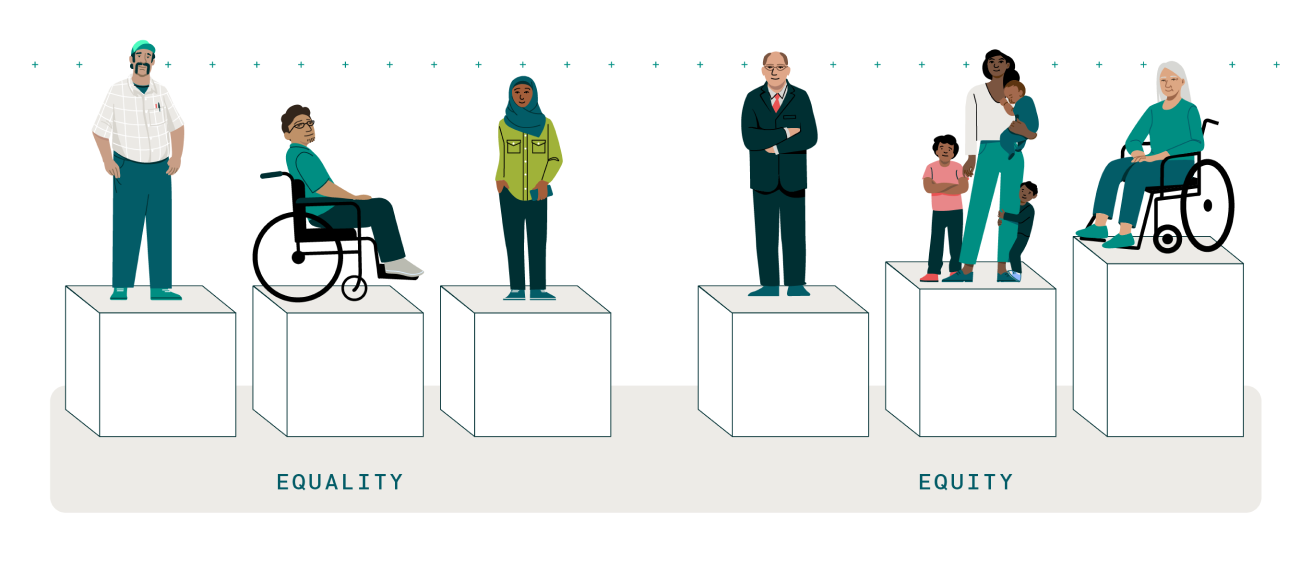Understanding health equity
Disparities in health impact your members. Read on to better understand how you can help advance health equity.

Social determinants of health (SDOH) vs. health equity
What are SDOH?
SDOH are the non-medical factors that influence health and health outcomes, such as life expectancy. These determinants include the conditions in the environment, socioeconomic factors and health behaviors.1
They are all around us and found in the infrastructure of our communities, the convenient care options we have access to, our socioeconomic status or the distance we must travel to buy fresh and nutritious food. These factors, among many others, are widely recognized as major contributors to our overall health and wellbeing.

What is health equity?
Health equity is the state in which everyone has a fair and just opportunity to attain their highest level of health, regardless of social, economic or environmental circumstances.2
Health equity is achieved in the absence of avoidable or remediable differences among groups of people. Understanding these differences and its root causes enables us to address them to give everyone a fair and just opportunity to achieve optimal health.


Who can be affected by health inequities?
Individual-level determinants such as age, race, sexual orientation and community factors such as access to quality health care, supermarket and transportation can influence their health outcomes.
6 in 10
Americans report experiencing a social need in the past three months4—this can include delaying care because of costs, housing and food insecurity
46%
of the U.S. population lives in areas of high and very high social needs risk5
13%
(17 million) of U.S. households were food insecure at some time during 20226
26%
of LGBTQ+ say their overall mental health is fair or poor7
Why health equity is important
Health inequities can significantly influence health outcomes. For example, poor housing conditions can exacerbate asthma, which may result in more visits to the emergency room.
Prevalence of costly chronic conditions like diabetes, obesity and cardiovascular disease is highest among those living in communities with very high risk of experiencing social needs.7 Individuals living in very high social need communities report less access to care, higher housing instability and more food insecurity than individuals living in low social needs communities.

Health equity is at the heart of our business.
See how The Cigna Group—fueled by Cigna Healthcare and Evernorth Health Services—is driving change.

Addressing health equity and improving health outcomes requires collaboration
The journey begins with understanding the needs of your member population and how to improve their overall health and wellbeing.
Understand where challenges are greatest using tools, such as the Evernorth Social Determinants Index (ESDI), that identify communities with greatest risks.
Quantify the impact of social determinants of health in your member population by combining medical and pharmacy data with the social determinants index.
Identify top challenges and convene to collaborate in solving these community level challenges.
Collaborating to innovate on health equity
With a long history in developing solutions that close gaps in care, our goal has always been to enable each and every person to achieve their full health potential, regardless of social, economic or environmental circumstances. We promise progress in meeting people where they are and aligning resources to assist where and when needed because not all needs are equal. We work to enable better health—even in the most challenging circumstances.
Guided and connected care
Our comprehensive, guided care solutions, such as our premier Employee Assistance Programs (EAP), deliver end-to-end support from diagnosis to recovery. By guiding the entire care journey, we help bridge gaps in health literacy, medication adherence, access to care and behavioral health for those who present a high level of need.
Also, with our data-driven care coordination solution, Health Connect 360®, case managers and clinicians leverage individual SDOH data to identify and address barriers that might exist for the member. These barriers may also be identified by specialized pharmacists who are trained to listen for SDOH indicators and provide tailored resources, helping clients save $62 PMPY in year one.9
Clients who use our EAP solutions have seen reductions in:9
24%
avoidable ER visits
51%
outpatient behavioral spend
32%
total behavioral spend
Affordable costs
Cost can be the most significant barrier to care in communities of lower income and socioeconomic status.
As one of the most expensive traditional conditions to treat, diabetes has a disproportionately high prevalence in communities with underemployment and lower income, as well as in those with limited access to nutritious foods, higher education, and health care.
That’s why our Patient Assurance Program makes treatment more affordable for those with diabetes and cardiovascular conditions. Enrolled members were able to improve adherence to their Type 2 diabetes treatments by 2.5%.10
In addition, our Smart90 program enables members to get 90-day supplies of their maintenance prescriptions at the same copay every time, no matter which pharmacy they choose. By enhancing cost predictability, Smart90 improved adherence by 19%.
Access to care and medication
Transportation and geographic distance to care can negatively impact a person's wellbeing as much as cost.
That’s why Evernorth is championing telehealth services and home delivery for prescription medications in partnership with MD Live by Evernorth by and Express Scripts, by Evernorth.
MD Live’s virtual care helps fill a gap in care by providing primary care services. In fact, 70% of patients who used virtual services with MD Live had not seen a primary care physician in the past two years.11
With Express Scripts Home Delivery, members can have their medication arrive right at their door, safely, quickly and accurately without needing to travel to the nearest pharmacy. +85% of members receive their medications within 7 days, with refills taking an average of 4 days to avoid gaps in medication adherence.12
Dedicated support
Patients with more complex conditions have highly specific needs that can easily be overlooked without access to the right support, and this can have costly impacts on their health.
Accredo by Evernorth, screens each specialty patient for SDOH, offering personalized clinical counseling and a wide range of supportive resources to members who need it most—including home infusions and social worker support. Accredo infusion nurses traveled more than 8M miles in one year to support patients’ need for in-home care, and perform 13.5K visits per month on average.13
Our In-Home Primary Care service focuses on providing care in the home to the most high risk, high need patients in your plan. This program targets populations with 5+ chronic conditions and identifies potential social barriers to close gaps in care. We do this by offering 24/7/365 support.
We’ve made progress, but there is more to do
Our commitment to progress in health equity is clear. We know that we can make a difference and every day we take more meaningful steps to get there.
We have breadth of talent, depth of expertise, industry-leading data and a fearless innovation on our side. We know we still can’t remove all the challenges and barriers that exist. Removing barriers to health will always be at the forefront of what drives us to be a better partner to you and the population you serve. Together, we can enact greater change and help more individuals become their healthiest selves, one step at a time.




Sources
- Hayes, Tara O’Neill and Delk, Rosie. “Understanding the social determinants of health.” September 4, 2018.
- Centers for Disease Control and Prevention (CDC).
- County Health Rankings and Roadmaps: A Robert Wood Johnson Foundation Program (2019). County health rankings model.
- Vitality In America Study 2023.
- Evernorth Social Determinants of Health Index and Census Data—ENRI Research.
- USDA Economic Research Service. “Food Security Status of U.S. Households in 2022”.
- Evernorth cardiodiabesity report—part one.
- Ani Turner, The Business Case for Racial Equity, A Strategy for Growth, W.K. Kellogg Foundation and Altarum, April 2018.
- Client results may vary.
- Internal analysis of patients with Type 2 diabetes enrolled in Express Scripts Patient Assurance Program in 2021.
- MDLIVE Reports Strong 2021 Growth Driven by Surge in Behavioral Health, Rapid update of Virtual Primary Visits. 2022. MDLive.com
- Express Scripts Pharmacy internal data. Individual results may vary.
- Accredo Ops Insight data as of Q3 2021.